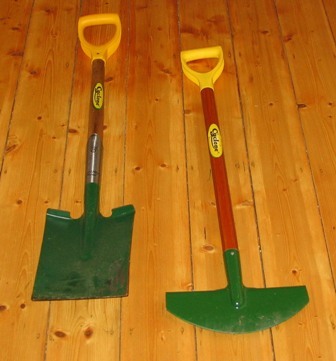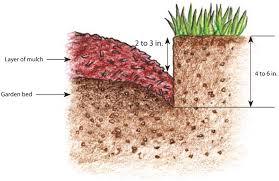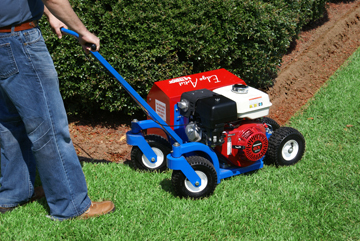Landscape Architecture for Landscape Architects › Forums › DETAILS & MATERIALS › Edging to separate lawn from a rock bed?
- This topic is empty.
-
AuthorPosts
-
May 20, 2014 at 5:02 am #152717
Anonymous
InactiveSo it’s a bed of rocks with no plants, adjacent to lawn. Sorry I missed that somehow (duh). OK, why not use some kind of chopped stone for edging? It will probably do as good a job or better than steel/aluminum edging at slowing down the grass from migrating into the beds because of its thickness and the maintenance contractor can just use a string trimmer against the edge stones for a clean look. The stone can be installed easily by most contractors on difficult topo. Concave or convex grades can be a pain to install long straight edging in. I’ve seen so many poorly installed metal and plastic edging that I prefer not to use them.
The main thing I’m getting at here is that it’s very difficult train grass not to send rhizomes underneath or through a thin edging material. The only thing I’ve had work for me is concrete edging 10”-12” wide, but that’s a completely different look and can be costly. Since the edging doesn’t stop the grass from spreading into the beds without regular maintenance, why not just deep edge early in the spring and maintain a crisp edge with an edger or a trimmer with a steel blade attached every 2 or 3 weeks? If you’re using 2”-4” river rock as a ground cover just rake it back 8” or so, deep edge and rake the rock back. It just looks so much better and safer than metal edging. Then you don’t have to worry about your client’s kid or even worse the neighbor’s kid running across the lawn and falling on edging and splitting their head open. Plus, they don’t have to spend the money on edging and they can put that money towards maintaining the beds properly.
As a young designer in Texas, I specified miles of steel, vinyl and aluminum edging at great cost to some of my clients. I went back home to the mid-West and I was visiting a friend who lived in a nice sub-division and they had acres of planting beds. They probably had a few miles of beds to deep edge, but they looked great. Then I started noticing the fine gardens that I visited never had any edging material. I realized that I had been using metal edging just because that was what everyone else was doing.

 May 20, 2014 at 5:11 am #152716
May 20, 2014 at 5:11 am #152716Anonymous
InactiveI agree after years and years of deep edging you can have the bedline drift outward, but if done properly only an inch or two is removed along the existing edge. If you only deep edge once a year it takes a long time to expand a bed and a lot of times as the plants grow you need to expand the beds a little anyway. But, I can’t disagree with you about the edging material maintaining the original bedline.
May 20, 2014 at 5:13 am #152715 Andrew SpieringParticipant
Andrew SpieringParticipantOh, now your talking turf species! Like the additional info Craig 🙂
Yes, stolons/rhizomes are a nightmare. So, be sure to specify a bunch grass like tall fescue, rye, or bluegrass (if you can grow them in your area). Stay away from bermuda and St. Augustine!
May 20, 2014 at 4:56 pm #152714Anonymous
InactiveDaniel:
Not to shoot holes in your game. I’ve used your great products for years for brick pavers and even applications it’s not intended for, but as a designer I most often choose not to use it to edge planting beds. Once again you’re absolutely correct about the fact it maintains the original bedline, so if that’s what’s important to the designer, I say go for it. I just want to let young pros that there’s a different way to do things.
Sorry, I guess I should have said this first.
May 20, 2014 at 6:13 pm #152713Anonymous
InactiveNice point you bring up there Andrew. I was initially cautious, because what works in the mid-West and northeast doesn’t necessarily work in the rest of the country. My first thought was that the longer growing season in the rest of the country, along with the different types of turf grasses might be a problem. I stuck my neck out (my boss didn’t know) and had a couple of residential and commercial clients try to go “edger-less” and it worked. After several seasons it worked out fine. It worked with Bermuda, 419 Tif and St. Augustine in North Texas, just like it worked in the mid-West. I have to say the St. Augustine looked the best, because it’s such a thick mat it cut clean like a shag rug. My non-scientific two cents is that in colder climates the plants have a shorter growing season, so maybe the cold climate turf grasses grow more aggressively during that smaller window than warm climate turf grasses. If there’s any turf experts in the Lounge, I sure would appreciate your input.
May 20, 2014 at 7:08 pm #152712 Jay SmithParticipant
Jay SmithParticipantCraig, I hear you about the natural deep edging being the best way to go and 99% of the time that’s my preference, however with this particular job (it’s a small job on a tight budget in Florida) the existing turf is not in the best condition. It’s St. Augustine that was put down years ago over poor soil conditions without an irrigation system. The soil itself is extremely sandy and makes for a sloppy edge, even when edged regularly. I’m just thinking the steel edging would help the curvilinear bedline hold it’s crisp edge over time, and could be relatively inconspicuous if installed deep enough. The chopped stone might be a possibility depending on cost, but I really don’t want an edging that becomes such a dominant element that it detracts from the overall design.
May 20, 2014 at 8:27 pm #152711 Daniel MartinKeymaster
Daniel MartinKeymasterNo problem, Craig. We know we are not the solution for every designer on every job. We just try to make the highest quality products for as many varied applications as we can, so when the designer does need edging, he knows where to turn.
Thanks for all of your valuable input to the discussion.
May 23, 2014 at 7:05 pm #152710 Daniel MartinKeymaster
Daniel MartinKeymasterJay, Not sure where you got the Permaloc prices, but Permaloc’s edging tends to be equal or less than steel. Especially for residential. Call the Permaloc offices and they should help you out.
-
AuthorPosts
- You must be logged in to reply to this topic.



